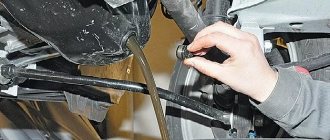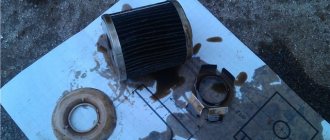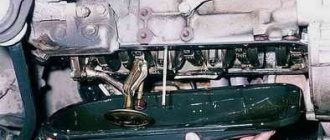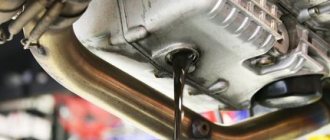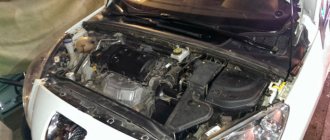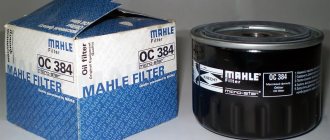The Niva SUV, in all modifications, is very popular in Russian spaces. This is due to good maintainability, low price and excellent maneuverability. To ensure reliable operation, you should undergo all maintenance on time, in particular, change the engine oil.
The VAZ 21214 engine lubrication system is designed to protect against premature wear of moving parts. It completely copes with its task, you just need to follow all the manufacturer’s recommendations.
Stages of replacing lubricant VAZ 21214
Changing the engine oil is a regulated maintenance procedure, which is prescribed in the operating instructions. There is nothing complicated about it if you clearly and carefully follow the described action plan.
The replacement operation will be the same for different modifications of the Niva car:
- VAZ 21214
- VAZ 21213
- VAZ 2121
- VAZ 2131
Our most popular engines are injection and carburetor engines, with a volume of 1.7 and 1.6 liters. The replacement process on these engines, as well as other modifications, will be the same.
Draining waste fluid
It is necessary to drain the used engine fluid when the engine is warm. This is due to the fact that heated oil is more liquid. This makes it easier for it to leak out of the thin channels of the lubrication system.
To drain old engine oil, it is advisable to drive the VAZ 21214 (Niva) onto a pit or overpass, since the drainage is done from below. If this is not possible, then the most inconvenient step will be unscrewing the drain plug. Especially if there is protection installed that will need to be removed.
When everything is ready, we proceed to the draining operation:
- Raise the hood, then find the filler neck on the engine and unscrew the cap (Fig. 1).
Fig.1 Oil filler neck - We unscrew the oil filter, which is located on the right side of the engine, on the spare wheel side. You can try to get to it from under the hood. But if the drain is made from a hole, then it will be more convenient to unscrew it from below (Fig. 2).
Fig.2 Oil filter - Now we go down under the car and place a waste container in the drainage area. You can use a cut canister or an old bucket.
- We unscrew the drain plug using a 12 hexagon, which is located in the front part of the internal combustion engine (Fig. 3).
Fig.3 Drain plug
To unscrew the filter element, it is advisable to have a special puller. If it is not available, you can try to unscrew the filter using improvised means. In this case, you can use, for example, an old alternator belt, a regular belt, a bicycle chain or a simple screwdriver.
Unscrewing the oil filter using improvised means
Using this method, you can drain the maximum amount of used oil, after which you can proceed to further actions. The main thing is not to forget, everything that we unscrewed must be put back in place.
Flushing the lubrication system
Flushing the engine on a Niva 21214, 21213 should only be carried out in exceptional cases, which include:
- Purchasing a used car when you cannot know about the quality, as well as the regularity of lubricant replacements.
- During operation, the service replacement interval was repeatedly exceeded.
- Engine operation with constant frequent overheating, which contributes to coking and other deposits.
- In cases of switching to another type, for example from synthetics to semi-synthetics.
There are several types of flushes for the Niva 2121 engine:
- Five- or seven-minute, capable of cleaning even the most difficult deposits. They must be used very carefully and strictly follow the instructions printed on the packaging. It is recommended to use them only when absolutely necessary. Since there is a high probability of causing premature wear of the sealing seals. And also clog the oil channels with particles of washed away carbon deposits.
- Special compounds that are added to the oil several hundred kilometers before the expected change. They are more gentle, but there is also a possibility of clogging of the oil channels.
- Flushing oil is the most gentle method of cleaning the engine from the inside. This composition is poured after draining the waste, the engine runs for 15-20 minutes, after which the liquid with deposits is drained. The absence of aggressive additives in the wash composition gently cleans the engine, but is not able to remove heavy contaminants.
- Regular oil that you are going to use when changing. This method is not so popular due to its high price.
Before flushing a VAZ Niva, you should weigh all the pros and cons. And also understand that it will not be possible to completely drain the liquid. Some of it will remain in the channels, which will then mix with the new oil.
Installing a filter, filling in new engine fluid
If the lubrication system of the VAZ 21214, VAZ 21213 (Niva) is sealed and does not require repair work to eliminate leaks, you can proceed to adding fresh oil. In addition to the engine oil itself, sometimes, when worn, it is recommended to change the bolt closing the drain hole. The original has article number 2101-2401046. As well as the original LADA oil filter 2105-1012005-82, from the factory, it is often installed from. If you wish, you can look at analogues on the Internet.
Consumables for maintenance
When everything is ready, let's move on to the bay:
- Replace the drain plug and replace it with a new one if necessary.
- We wipe the seat under the filter.
- We tighten and put in place the new oil filter. Pre-lubricate the rubber sealing ring with fresh oil.
- Pour new oil into the filler neck.
- We check the level on the dipstick; it should be between the MIN and MAX marks.
- We start the engine, let it run for 10-15 seconds, then turn it off.
- After 5 minutes, check the level with a dipstick and top up if necessary.
There are several opinions regarding replacing the oil filter. Many old-school owners advise filling it with new oil before installation. However, nothing is said about this in the official Lada Niva operating instructions. And also in information from global filter manufacturers it is recommended to simply lubricate the o-ring.
Instructions
- We warm up the engine to 45-50 degrees. Warm oil has better fluidity and will drain better from the engine during a complete replacement. Our task is to remove as much as possible the old dirty and used fluid that no longer has useful properties from the engine and fill it with new one. If a lot of old dirty oil remains in the crankcase, it will be swept away with the new one and will worsen its beneficial properties. Warm up the engine for 5-7 minutes before starting, this will be sufficient.
- For easy access to the drain plug (and in some models the oil filter is also attached from the bottom) and the bottom of the car as a whole, you need to jack it up or drive into an inspection hole (the best option). Also, some models may have engine crankcase “protection” installed.
- We open air access to the crankcase by unscrewing the filler cap and dipstick.
- Place a large container (equal to the amount of oil being poured).
- Unscrew the drain plug with a wrench. Sometimes the drain plug is made like a regular “bolt” under an open-end wrench, and sometimes it can be unscrewed using a four- or hexagon. Don't forget to wear protective gloves, the oil will most likely wake you up warm, but you need to be careful.
- We wait about 10-15 minutes until the waste flows into a basin or cut-off plastic canister.
- Optional but very effective! Flushing the engine with a special liquid is not included in the maintenance regulations and is not mandatory - but. By getting a little confused, you will be much better at flushing out the old, black oil from the engine. In this case, wash with the old oil filter for 5-10 minutes. You will be surprised at the black oil that comes out with this liquid. This liquid is very easy to use. A detailed description should appear on the flushing fluid label.
- Changing the sedum filter. In some models, it is not the filter itself or the filter element (usually yellow) that is changed. Don’t forget to “impregnate” the filter with fresh oil. Pour approximately 50-100 g directly into the filter. These simple manipulations will help avoid the so-called “oil starvation” of the engine in the first seconds of operation. Also remember to lubricate the rubber O-ring before installation.
- Fill in new oil. Having made sure that the drain plug is screwed in and a new oil filter is installed, we can begin to fill in new oil using the dipstick as a guide. The level should be between the minimum and maximum marks. Also, you need to remember that after the first start of the engine, some oil will leave and the level will drop.
- In the future, when the engine is running, the oil level will probably change; be careful during the first few days of operation. Recheck the oil level using the dipstick after the first start.
Replacement frequency, what oil to fill
According to the manufacturer's regulations, service replacements of engine oil for Niva 2121 and other modifications are carried out after 10,000 kilometers or at intervals of 1 year. But some car owners consider this interval to be a little too high, recommending that it be shortened taking into account operating conditions.
At the factory, Niva models are filled with oil from different suppliers. Most often this is Petro-Canada Supreme 10W-40 or Lukoil Genesis Advanced 10W-40. But for accurate information about what is poured into your car from the factory, you should contact the feedback system of AVTOVAZ PJSC. When applying, you must indicate the year and month of manufacture of the car.
Products from other manufacturers can be used as lubricating fluid. When choosing, it is recommended to pay attention to semi-synthetics with a viscosity of 10W-40. The following motor oils are most popular among model owners:
- Lada Professional 10W-40
- Shell Helix HX7 10W-40
- Total Quartz 7000 10W-40
From this list, anyone can choose based on preference, price or love for the brand.
When using this car in winter, you should select oil taking into account the climate zone, as well as the recommendations of AvtoVAZ. Viscosity 5W-40 will allow you to operate the car down to -30°C, and 0W-40 up to -35°C.
If you use motor oil of different viscosities for winter and summer, but of the same brand and manufacturer, then flushing is unnecessary.
How much oil is in the engine lubrication system, volume table
| Model | Engine capacity | Motor marking | How many liters of oil are in the system | Original oil / factory filled |
| Niva (Lada VAZ 21214, 21213, 2121, 2131) | gasoline 1.8 | VAZ-2130 | 3.75 | Lada Professional 10W-40 / Petro-Canada Supreme 10W-40 |
| gasoline 1.7 | VAZ-21214 | |||
| VAZ-21213 | ||||
| gasoline 1.6 | VAZ-2121 | |||
| VAZ-2106 |
Chevrolet Niva
... loosen the filter with a puller (for clarity, we show the operation on the removed filter).
... loosen the filter with a puller (for clarity, we show the operation on the removed filter).
If there is no puller, we pierce the filter housing with a screwdriver (closer to the bottom, so as not to damage the engine fitting) and unscrew the filter, using the screwdriver as a lever.
Leaks and problems
The higher the mileage of the VAZ Niva, the more problems appear, as in principle with any car. Most often this is due to natural wear and tear of the engine, causing oil to burn. Although the manufacturer allows for a small consumption.
There can be many reasons why an engine eats oil. And in each case they can be individual. But, over the years of the model’s existence, we can talk about the most common places where leaks occur.
If the breather is spewing or throwing oil, or if there is oil in the exhaust manifold, this may indicate a serious problem with the oil rings. In this case, you can try decoking with dimexide. But it is better to use special auto chemicals designed for these purposes.
A leak from under the valve cover may be due to a worn gasket. Sometimes simply replacing the gasket does not solve the problem. Since the cover itself may have significant curvature. Therefore, in some cases it will have to be replaced.
A white emulsion in the engine or on the oil filler cap may indicate condensation. This is a common occurrence when temperatures change from minus to plus, mainly in autumn or spring.
But if the emulsion is also observed on the dipstick, then this is already a sign of more serious problems. Most often we can talk about a broken cylinder block gasket. And in rare cases, a cracked cylinder head may be to blame.
Also, with this problem, you can find oil in the expansion tank. Sometimes, simply replacing the gasket is not enough. It may be necessary to grind the head itself, and this is completely different money for repairs.
All this is general information, which may manifest itself differently on each specific vehicle, since everyone’s operating modes are different. The same applies to leak locations; it is impossible to identify the cause from a distance.
What will you need for the job?
We recommend buying oil with a small reserve, just in case you suddenly need to add liquid after a while. You will also need the following things:
Niva oil filter
- container for draining used oil;
- box spanner for pan bolts;
- flashlight;
- hexagon for drain plug;
- special oil filter puller or screwdriver.
The car must be lifted on a lift or jacks, or driven onto an overpass. Jacks are not the most convenient option, but if there is no choice, nothing can be done.
Before driving onto the lift, the car should be warmed up, since in this case the oil will drain from the engine better due to the fact that it will be more liquid.
A trip to the mother-in-law - how much gas does Shevik consume?
Aloha to all fans of the Chevrolet Niva. Yesterday we came on a short cruise - we drove 300 kilometers one way to my mother-in-law. Here I would like to describe my feelings from the trip.
First, we filled up with 92 gasoline for 700 rubles (the price tag here is 31 rubles in Kirov). Drive to Rudnichny 290 km one way.
The first 90 kilometers the road is good, but the trucks constantly go non-stop, plus there are permanent settlements where the gays really like to stand.
I don’t have a radar detector yet, so I had to cut the first hundred at 70-80 km/h. I drove mostly in 4th gear, approximately 2900 rpm.
However, as soon as I left Belaya Kholunitsa, where the road was empty, I immediately drowned the kid there, since my tires were not studded, and there the road was powdery (late February), I didn’t drive too hard, I was driving at a cruising speed of 90 km/h in 5th gear.
Having reached Kirs (240 km from Kirov), it was decided to top up the little guy with gasoline, because there was still a lot left. And oppa - there is no 92 gasoline. I had to add 6 liters of 95 to get 45 km. And then I felt the difference - the car drove, even uphill in fourth gear - it pulled without problems.
So if the instructions recommend pouring 95, pour it, the only thing is that it may be of low quality. I used Lukoil, everyone praises it.
For 45 kilometers I just flew like on wings, in 5th gear the speed was 90 km/h, I didn’t even shift on hills)) However, as people say, it’s hard to start at 95 in the cold, when we arrived (north after all), it was frosty minus 28.
However, the next day they promised warming, we got ready to go back for lunch - the temperature was already -15, and the sun was warming up at the end of February. So even on 95 gasoline they started.
We drove to a local gas station and filled up with 800 rubles worth of 92nd.
Read my blog, subscribe, spring and summer are coming - there will be a lot of travel, which means there will be photo reports on fishing and searching with a metal detector. It will be interesting))
DETAILS: Recommended tire and wheel sizes for Niva 4x4 » Lada.Online
Video materials
The video recommended below will help you understand the small nuances of changing engine oil on a Niva.
- Hello! My name is Sergey, I am a mechanic with 7 years of experience.
I’ll be happy to share tips and techniques that I use myself.
If you need anything, please contact us via feedback (at the bottom of the page).
The Niva SUV, in all modifications, is very popular in Russian spaces. This is due to good maintainability, low price and excellent maneuverability. To ensure reliable operation, you should undergo all maintenance on time, in particular, change the engine oil.
Power unit
The engine installed on the modern model of the Niva 21213 (214) car was inherited from its Soviet progenitor - the VAZ 2121, and in terms of fluid volumes they are almost identical:
- Liquid cooling system. Filled with antifreeze in an amount of 10.7 liters with a freezing point not higher than -40 ° C. The capacity of the interior heating radiator is also included in this volume.
- Crankcase. Motor oils are poured here, the brand of which depends on the operating conditions. Capacity: 3.75 liters, including oil filter filling.
| Lower limit of ambient temperature, °C | -20 | -25 | -25 | -30 | -30 | -15 | -35 | -30 |
| Upper limit of ambient temperature, °C | 45 | 35 | 45 | 35 | 45 | 45 | 25 | 30 |
| SAE lubricant viscosity grade | 15W-40 | 10W-30 | 10W-40 | 5W-30 | 5W-40 | 20W-40 | 0W-30 | 0W-40 |
When flushing the power unit during the process of replacing liquid lubricant, the same amount of flushing oil (3.75 l) is used, taking into account the size of the filter. Replacement is carried out after 8-12 thousand kilometers, depending on the quality of the oil. Flushing is usually performed after 3 engine lubricant changes. During operation, it is important to monitor the oil level in the engine crankcase using a special dipstick. If the level drops below the Min mark, it is urgent to add lubricant to the engine of the same viscosity as was previously filled.
Antifreeze needs to be updated at least once every 3 years or according to the degree of wear of the fluid. It is not recommended to dilute antifreeze with distilled water, either in winter or summer. In winter, the diluted liquid may freeze, and during the summer heat it may boil ahead of time, which will lead to overheating of the engine.
Organizational plan
Organizing an oil change business is not difficult. First you will have to legalize your activities. Next, you have to purchase equipment, find a suitable room for work and form a staff. Before launching, you should work on attracting your first clients.
How to register a business?
Oil change point clients are individuals. In this case, it is advisable to register an individual entrepreneur. To register an activity, you need to come to the tax office and write an application on form P21001. Have the following documents with you:
- passport;
- TIN;
- a receipt confirming the fact of payment of the state duty in the amount of 800 rubles.
No later than 30 days after submitting the documents, you must write an application to switch to the simplified tax system. A convenient rate for this type of activity is 6% of income. You will also have to select OKVED codes. The following are suitable for an oil change point:
- 45.2 – Maintenance and repair of vehicles (main group);
- 45.20;
- 45.20.1;
- 45.20.2;
- 47.30.2.
Search for premises
To organize a business, you will need a small separate room, such as a box, with convenient access roads. The ideal location is near one of the gas stations or car washes of the city in a densely populated part of it. Requirements for it:
- total area – at least 50 m2;
- electricity supply;
- connection to a central water supply and sewerage system is desirable;
- An additional advantage will be the presence of a small parking lot.
Equipment
To operate the point effectively, you will need the following equipment:
- a lift for cars (you can do without it if there is an inspection hole);
- vacuum unit for pumping out oil – 2 pcs.;
- set of tools;
- a set of nuts and bolts of various calibers;
- workwear.
The cost of purchasing equipment will be about 150,000–200,000 rubles.
Personnel and requirements for them
At the initial stage, two workers will be needed to service the cars. The managerial position will be occupied by the business owner. He will also purchase oils from suppliers and monitor the assortment. It is better to outsource accounting.
Personnel requirements:
- have at least 2 years of experience in oil changes;
- politeness, culture of speech;
- no criminal record;
- decency;
- punctuality.

